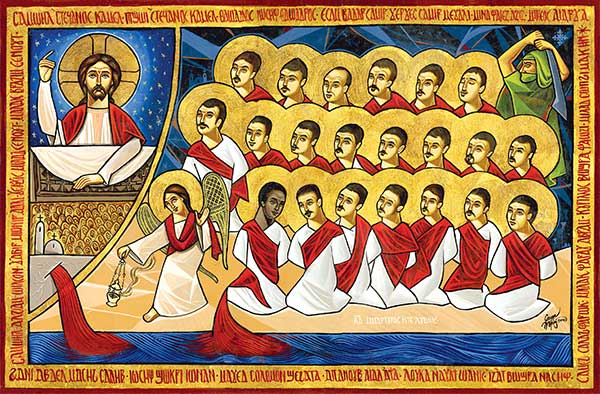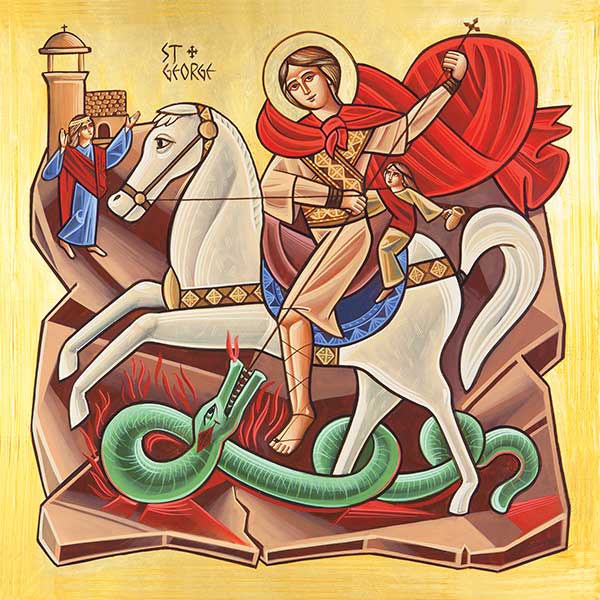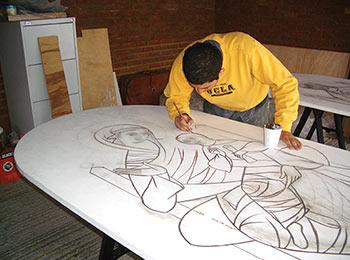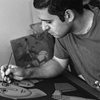Subtotal: $
Checkout-

Making a Work of Art
-

The Business of the Artist
-

The Creative Process
-

Return to Appalachia
-

Excerpt: Mandela and the General
-

Why We Live in Community: A Manifesto
-

Editor’s Picks Issue 18
-

The Sacred Bonds of Sound
-

Making Music for Community
-

A Man of Honor
-

Wassily Kandinsky
-

Giant Picnic
-

Covering the Cover: The Art of Community
-

The Art of Community
-

Readers Respond: Issue 18
-

Family and Friends: Issue 18
-

I Did Not Leave
-

Summer of the Tree House
-

Warriors on Stage
-

The Beauty of Belonging
-

Insights on Beauty
-

It Could Be Anyone

In 2015 the worldwide Egyptian community received the devastating news that twenty-one Coptic Christians had been martyred by the Islamic State. These Christians were soon declared saints of the Coptic Orthodox Church – a faith through which they would have been intimately familiar with the icons of saints who came before them.

A 2016 icon by George Makary portraying the twenty-one Coptic Christians martyred by ISIS in Libya in February 2015. Artwork reproduced by permission from George Makary
The production of icons to venerate new saints is a richly rewarding task. But it also raises an important question: How can an iconographer portray a modern saint in a recognizable way, yet in a way that remains consistent with the abstract Coptic style?
As an iconographer for the Coptic Orthodox Church, I know this challenge well.
Already a subscriber? Sign in
Try 3 months of unlimited access. Start your FREE TRIAL today. Cancel anytime.
Early Christian Roots
Iconography has existed since humans learned they could create; it extends back to prehistoric cave paintings and sculpture. In Christianity, the tradition of sacred painting goes back to the earliest years of the church. The purpose of iconography is to call viewers to prayer and to educate them. According to the fourth-century church historian Eusebius, the first icons of Jesus were created before his Ascension. Although Eusebius himself disapproved of icons, he recalls visiting the house of the woman who, as recounted in the New Testament, had been healed by Jesus of a hemorrhage (Matt. 9:20–22):
Upon an elevated stone, by the gates of her house, [there is] a brazen image of a woman kneeling, with her hands stretched out, as if supplicating. Opposite this is another upright image of a man … extending his hand toward the woman. At his feet, beside the statue itself, is a certain strange plant, which climbs up to the hem of the brazen cloak, and is a remedy for all kinds of diseases.footnote
Eusebius also mentions the case of King Abgar of Edessa, who received from Christ an image of Christ’s face imprinted on a cloth, and was thereby healed of an incurable illness.
Icons like this cloth (and the Shroud of Turin) have been offered as evidence that the prohibition against divine images given by God to Moses in the Old Testament (Exod. 20:4–6) was overturned by the incarnate Christ. Indeed, it has been argued that the lack of images of God in the Old Covenant signified faith that no one had truly seen God, while the opposite in the New Covenant is a declaration of faith that God has been seen. According to legend, the disciple Luke was the first to paint an image of the Holy Mother Mary carrying Christ. In Coptic iconography there are countless parallels between modern treatments of Christ and Saint Mary and very early Christian imagery – even parallels to ancient Egyptian religious symbolism. Perhaps the most obvious are in images of the Flight into Egypt. Mary’s sky-blue clothing likens her symbolically to the ancient Egyptian sky goddess Nut, said to give birth to the sun god Ra every morning. This parallels Malachi, where Christ is prophesied to be the “Sun of Righteousness, rising with healing in its wings” (Mal. 4:2).
Icons in the Coptic Church Today
The Coptic Synod doesn’t often announce new saints, but even before the twenty-one martyrs, two saints were canonized in 2013: Pope Kyrillos VI and Archdeacon Habib Girgis. These new saints, unlike early Christian saints, were men whom people still living had known personally. Their canonization was a reminder, too, of how the Coptic Orthodox Church had changed during their lifetimes. Once a church whose geographic reach did not extend far beyond Egypt, it is now a growing and thriving family around the world. Dozens of churches are founded every year, particularly in North America.
The new generation of Western-born Copts is under enormous pressure to establish what it means to be a Coptic Christian outside the motherland, and the resulting mix of Western and Eastern influences creates a dichotomy of cultures and tastes that are difficult to reconcile. Chief among these areas of contention is the iconography of the church.
In Theology of the Icon, the twentieth-century iconographer and theologian Leonid Ouspensky writes that an icon should be rendered “in the visual language of its time.”footnote Yet what, considering the great diaspora of Coptic Christians, is the visual (and cultural) language of our time? Young Coptic iconographers are having a hard time answering this question.
Finding the way forward compels us to look back at how Egypt’s rich and ancient artistic history gave rise to today’s iconography. Egyptian art has been heavily influenced by visiting or immigrant cultures. Greek influence is evident in the Fayum funerary portraits (circa the first century BC to the third century AD), which show a more naturalistic style infiltrating the abstraction of the earlier Egyptian painters. In the sixteenth to eighteenth centuries, Byzantine characteristics were frequently seen in Coptic iconography. During the 1800s and 1900s, prints of Catholic saints painted in the realism of the Italian Renaissance dominated new iconography in Egypt. Copts had apparently lost almost all knowledge of their earlier, abstract style.
Then in the mid-1960s, Isaac Fanous, an Egyptian Copt and art teacher, sought to rediscover and re-establish an authentic Coptic style. After studying in France at the Louvre and under Ouspensky, Fanous returned to Egypt and developed what is now known as the Neo-Coptic style. This style carefully takes into account the symbolism used by ancient iconographers and values an understanding of early Coptic painting and textiles, but also makes use of cubism and other modern modes of expression.
Fanous’s students vary widely in their commitment to his teachings, and a modern Coptic church has at its disposal a range of iconographers whose work runs the gamut from Fanous’s Neo-Copticism to the Italian naturalistic style that their grandparents knew in Egypt.

Fadi Mikhail, Icon of Saint George, presented by Archbishop Angaelos of the Coptic Orthodox Church to the Prince of Wales in 2013 upon the birth of his grandson Prince George. Artwork reproduced by permission from Fadi Mikhail
The photographic record has also had an effect on modern icon style. If an image is rendered too realistically, the iconographer risks inventing personal features and forcing his own subjective interpretation onto the viewer. Thus icons traditionally avoid extremes of facial expression – large smiles, angry scowls, expressive weeping. Therefore, when Coptic iconographers make icons of new saints – whose faces we know from photographs – they strive to abstract the faces to match, as closely as possible, the more geometrically rendered faces of older saints. But some of the most powerful photographs of Saint Pope Kyrillos VI, for example, show him smiling and staring deeply at the camera. I believe that if a saint was known to show great love and compassion in his face, then it is consistent with the spirit of iconography for an icon to express this.
Icons and Technology
Artistic style is not the only determining factor in the appearance of today’s icons: cost is always an issue. When a church wants new icons, for example, it can choose to commission an experienced but expensive iconographer living in the West, or to seek an iconographer in Egypt whose prices can be more competitive. Alternatively, churches might employ young icon enthusiasts from within their congregations. Using printed reproductions is even cheaper – but that is not without other costs.
Recently a friend of mine heralded the installation of some icons on the ceiling of his church. These were digital (computer art) images of the four evangelists, “painted” on a digital tablet and printed on canvas. I argued that one of the most beautiful characteristics of the handmade icon is how it offers back to God parts of the different earthly kingdoms that he gives us. From the animal kingdom we use egg to create egg tempera paint. From the mineral kingdom we use natural pigments. From the vegetable kingdom we use wooden boards. Finally, from the human kingdom we use our own God-given creativity. By replacing these authentic materials with printer ink and plastic, are we reducing the beauty of the icon?
Reprinting existing icons is certainly faster, cheaper, and easier than commissioning new work. Yet at the same time, do we not reduce the beautiful symbolism contained in the artistic process when we create single-layered images using a computer? For the artistic process of handmade iconography is anything but single-layered. It is in itself a parallel of the spiritual journey of the believer. As Monica René, an expert in Coptic culture, writes:
If an icon is about anything at all, it is firstly about light. The technique of egg tempera can be seen as a metaphor for the ascent of the soul from the darkness of the material plane into the light of the spirit. … Symbolically [the application of the dark base layers of an icon] represents our state of blindness to the things of the spirit or separation from the divine, or absence of light. Later, after re-establishing order by redefining the original line drawing, the iconographer begins to apply the light, gradually adding brighter layers. … Thus the saint progressively “appears” from the darkness into the Taboric or heavenly light.footnote
Icons and Mission
Whether its creation is a spiritually-rich metaphor or simply the product of an inkjet, the modern icon continues the enlightening work of sacred painting begun in ancient times.
First and foremost an icon is to declare in images – just as the gospel does in words – that we believe in the incarnation of God the Son. We believe that making an image of Jesus of Nazareth constitutes a faithful declaration that although he is fully God, he can be portrayed in the flesh, because he took on flesh and we have seen him with our own eyes. Second, an icon must be a visual reminder of the spiritual realm in which we live: a community of living saints who came before us – or who have lived among us – and continue to inspire us to “be holy, as [God] is Holy” (1 Pet. 1:16).
True, images can never replace a person. They are simply windows to look through, inviting us to remember the deeper feelings and devotions that the person brought to light. This is the role of the icon in the Coptic Church today: spreading the Light of the World.

Footnotes
- Eusebius, Ecclesiastical History, chapter 18.
- Leonid Ouspensky, Theology of the Icon (St. Vladimir’s Seminary, 1992).
- Monica René, “Contemporary Coptic Art,” Coptic Civilisation: Two Thousand Years of Christianity in Egypt (American University in Cairo, 2014), 279.
Already a subscriber? Sign in
Try 3 months of unlimited access. Start your FREE TRIAL today. Cancel anytime.
































